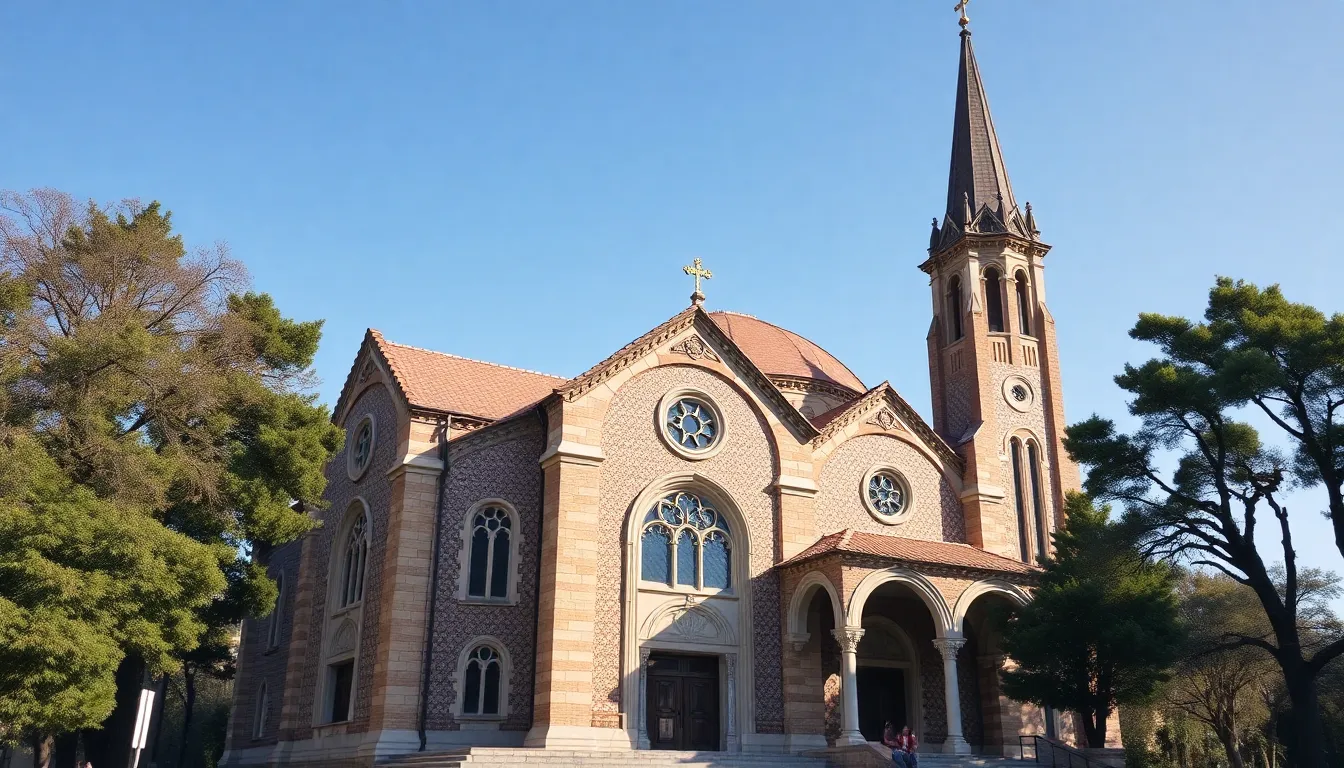<a href="https://wintersummerinn.com/switzerland-architecture“>Jewish architecture tells a captivating story that intertwines faith, culture, and history. From ancient synagogues to modern designs, it showcases a rich tapestry of creativity and resilience. Picture a world where every arch and dome whispers tales of tradition and innovation, inviting curious minds to explore its unique beauty.
Table of Contents
ToggleOverview of Jewish Architecture
Jewish architecture reflects a rich tapestry of cultural and religious narratives. Ancient synagogues illustrate the early expressions of faith and community, showcasing diverse styles such as Romanesque, Gothic, and Moorish influences. Each design element serves a purpose, from the bimah—an elevated platform for Torah reading—to the ark that houses the Torah scrolls.
Contemporary Jewish architecture continues this tradition, often merging modern aesthetics with historical references. Structures like the Jewish Museum in Berlin emphasize the significance of memory and identity. Geometric shapes and innovative materials characterize many new designs, fostering a connection between past and present.
Synagogue interiors often feature intricate decorations, highlighting tradition through stained glass windows, murals, and decorative motifs that convey spiritual symbols. Public buildings such as community centers and schools reinforce the importance of Jewish culture in urban environments.
Regional variations demonstrate adaptability in Jewish architecture. In Eastern Europe, wooden synagogues exemplify craftsmanship and local materials, while in Israel, modernist designs echo the country’s unique landscape. Cities worldwide showcase synagogues that integrate local architectural styles with Jewish elements, enriching the global heritage of Jewish architecture.
Jewish architecture is dynamic, constantly evolving while rooted in historical context. Each structure embodies a story, bridging generations and fostering community bonds. This architectural legacy invites all to appreciate the interplay between faith, community, and creativity.
Historical Development

Jewish architecture showcases a significant evolution influenced by various historical contexts. Its development spans ancient influences and medieval adaptations, shaping the identity of Jewish communal spaces.
Ancient Influences
Ancient Jewish architecture primarily emerged during the Second Temple period. Synagogues from this time exhibited Hellenistic and Roman architectural features. Elements like colonnades and porticoes became common, blending with religious requirements. The layout typically included a central prayer area, allowing communal gatherings. Architectural remnants from places such as Masada and Qumran reflect this innovative period. These ancient designs emphasized function along with symbolism, creating a lasting foundation for future structures.
Medieval Adaptations
During the medieval period, architecture adapted in response to regional styles and local customs. Jews in Europe constructed synagogues that displayed influences from Romanesque and Gothic architecture. Key features included pointed arches and intricate carvings. Spaces often incorporated elements like the bimah and ark, essential for religious practices. Communities in Spain embraced Moorish styles, evident in rich tile work and ornate decorations. Adaptations not only served aesthetic purposes but also fostered communal identity amidst varying cultural landscapes.
Key Characteristics of Jewish Architecture
Jewish architecture embodies distinct design elements and rich symbolism that reflect its cultural significance. Examining these aspects reveals the intricate connection between form and function.
Design Elements
Architectural features frequently define Jewish buildings. The bimah, a raised platform for reading the Torah, serves as a focal point. In addition, the ark, which houses the Torah scrolls, holds spiritual importance, often adorned with elegant craftsmanship. Arches and domes frequently appear, echoing styles from surrounding cultures while maintaining unique identities. Windows often showcase elaborate stained glass, which enhance interior spaces with color and light. Community spaces within synagogues encourage gathering, emphasizing collective worship and connection.
Symbolism and Themes
Symbolism plays a pivotal role in Jewish architecture. The shape of synagogues often reflects a sense of upward aspiration, connecting the earthly to the divine. Themes of light and illumination appear throughout, symbolizing knowledge and divinity. Architectural motifs include the Star of David and other spiritual symbols, reinforcing faith and community identity. Over time, designs embraced local cultural influences while preserving core principles of Jewish life, crafting a visual narrative of resilience and tradition. Themes of memory and history continue to resonate in contemporary structures, merging the past with the present.
Notable Examples of Jewish Architecture
Jewish architecture features significant structures that embody cultural heritage and religious significance. Notable examples include synagogues and cultural centers that reflect distinct styles and community functions.
Synagogues
Synagogues represent central points for Jewish worship and community life. Each synagogue displays unique architectural elements, from the bimah’s raised platform to the intricately designed ark housing the Torah scrolls. The Great Synagogue of Budapest showcases a Moorish Revival style, while the Tiferet Yisrael Synagogue in Prague highlights Baroque features. Both structures emphasize beauty while serving spiritual purposes. Modern synagogues, such as the Levi Yitzchak Synagogue in Brooklyn, embody innovative designs, merging traditional aspects with contemporary aesthetics. They aim to create welcoming spaces that foster community engagement and spiritual reflection.
Cultural Centers
Cultural centers play crucial roles in Jewish education and community outreach. These centers often house educational programs, events, and artistic exhibitions, stimulating cultural identity. The Jewish Community Center (JCC) in San Francisco, for instance, provides a vibrant hub for social activities and cultural engagement. It combines functionality with distinctive architectural elements that reflect Jewish identity. Another significant example is the Menachem Begin Heritage Center in Jerusalem, which features modern design while documenting the historical narrative of Jewish leadership. Each cultural center contributes to a deeper understanding of Jewish heritage and fosters connections among diverse community members.
Contemporary Jewish Architecture
Contemporary Jewish architecture showcases a vibrant fusion of modern aesthetics and historical references. Design continues to evolve while reflecting cultural identity and community needs.
Modern Trends
Architects focus on creating spaces that promote inclusivity and interaction within contemporary Jewish architecture. Open layouts encourage communal gatherings, integrating natural light to enhance the environment. Innovative materials, like glass and steel, contribute to minimalist designs that embrace functionality. Examples include the Congregation Beth Elohim in Brooklyn, where modern architecture supports traditional practices through accessible spaces. Emphasis on multi-purpose areas allows for diverse community activities, promoting engagement while maintaining spiritual significance.
Sustainable Practices
Sustainability plays a vital role in contemporary Jewish architecture, aligning with values of stewardship and responsibility. Many projects prioritize energy efficiency by utilizing solar panels and green roofing. Implementing water conservation techniques also helps in creating eco-friendly environments. The Jewish Eco-Design initiative inspires architects to incorporate sustainable materials, ensuring reduced environmental impact. Green building certification, such as LEED, showcases commitment to sustainability in synagogues and community centers. These practices not only serve the environment but also reflect a dedication to future generations within the Jewish community.
Jewish architecture stands as a testament to resilience and creativity, weaving together faith and cultural identity. Each structure tells a story, reflecting the community’s journey through history while embracing modernity. The unique design elements and rich symbolism found in synagogues and cultural centers not only enhance spiritual experiences but also foster connections among diverse community members. As this architectural narrative continues to evolve, it invites appreciation for the interplay between tradition and innovation, ensuring that the legacy of Jewish heritage remains vibrant for generations to come.





